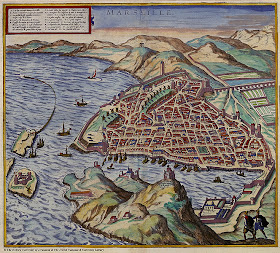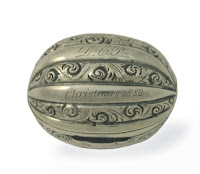Marseille is the oldest city in France -- founded by the Greeks in 600BC as Massalia (Μασσαλία). Under the Romans it became Massilia and went through occupations by the Visigoths and the Aragonese (according to Wikipedia) before becoming Marseille. Flirtations with the Ottomans (and so many others) brought other influences to the table …it was the great port city. Most of those interlopers left their imprint on the food of Marseille. Fish preparations like Bouillabaisse are the happy result.
I love the food of the Mediterranean region and it couldn’t be better represented than it is in one of my favorite cookbooks, A Mediterranean Feast by Clifford Wright. It is a 700-odd page mega-tome –– full to bursting with history, legends and incredible recipes that took him 10 years to complete. It won the top James Beard award in 2000 for a thousand reasons – scrupulous research, informed and creative discourse about the relationships and influences amongst the cuisines of the area and those brilliant recipes… it’s a great cookbook that makes you think. I use it often when I am in the mood for something from the region and I am never disappointed since it covers Europe to Africa and the Middle East and explores dishes of the past as well as modern favorites. I was especially impressed at the way Wright wrote of the influence of the Middle East on European Mediterranean food… it was quite an influence. The diaspora of so many cultures, through war or settlement or commerce, created exciting flavors as they contributed to the local cuisine with their native techniques and spices.
by Clifford Wright. It is a 700-odd page mega-tome –– full to bursting with history, legends and incredible recipes that took him 10 years to complete. It won the top James Beard award in 2000 for a thousand reasons – scrupulous research, informed and creative discourse about the relationships and influences amongst the cuisines of the area and those brilliant recipes… it’s a great cookbook that makes you think. I use it often when I am in the mood for something from the region and I am never disappointed since it covers Europe to Africa and the Middle East and explores dishes of the past as well as modern favorites. I was especially impressed at the way Wright wrote of the influence of the Middle East on European Mediterranean food… it was quite an influence. The diaspora of so many cultures, through war or settlement or commerce, created exciting flavors as they contributed to the local cuisine with their native techniques and spices.
I saw a recipe for soupe de poisson in Wright’s book and it cast a spell on me –– you can almost taste the salt air of the port of Marseille when you read it. This fish soup is a concoction of working class fisherman and the fish that were used were not fancy fish (those would be sold for money) -- these were the cheap, poor man’s fish that became the flavorful base for the soup.
What about the fish you use to make the soup? It's not just about taste, it's about sustainability and safety. Soupe de poisson is the original sustainable fish dish –– I used fish that aren’t high on the endangered list and got them from the wonderful Lobster Place in Chelsea Market, NYC. They are a great store with a superb and varied selection of fish –– perfect for a fish soup!
19th C. Fish
You can read about what fish you should buy or stay away from at The Environmental Defense Fund or the Monterey Bay Aquarium . It's good to know what you're buying isn't irresponsibly caught or farmed.
Aside from over-fishing, it’s disheartening to realize we now must worry about eating too much fish –– mercury and pollutants from fish farms that use toxic levels of pesticides and antibiotics to deliver cheap fish (as well as using huge amounts of fish and animal byproducts to feed them –– 10 to 20 pounds for 1 pound of fish), further polluting and decimating native fish populations –– it’s a vicious cycle.
This is what Veta la Palma fish farm looks like
There are exciting new alternatives you can read about HERE and in Dan Barber’s Ted Talk HERE as well as in the Saveur 100 this year. These alternative methods actually help the environment rather than destroy it and make for superbly flavored fish as well. A visionary named Luis Contreras has done it in Spain at an 8,000 acre wetland (out of a 27,000 acre estate) named Veta La Palma that produces 2000 tons of toxin-free bass, bream, eel, shrimp and sturgeon a year that are fed almost exclusively by an ecosystem that also cleans up after itself. The Dan Barber Ted talk was a real eye-opener for me. I have enormous respect for Barber as a chef and a proponent of sustainable agriculture and, of course, great taste as seen at Blue Hill at Stone Barns just outside NYC). Barber said the fish from Veta la Palma, were sublime. "Veta la Palma's fish is unlike any farmed fish I've ever tasted," he says. "It's unlike any fish I've ever tasted. It's sweet and clean – like tasting a bite of the ocean."
Once you've decided on the fish part of the soup, there is another classic component to the dish, rouille.
Once you've decided on the fish part of the soup, there is another classic component to the dish, rouille.
Rouille –– a garlicky, saffrony mayonnaise served with the soup on olive oil toasted bread. I was lucky enough to speak to Wright about his unusual version of the sauce that has bread as one of the ingredients. Wright told me this is a traditional part of the sauce that isn’t as familiar in the US as the straight egg and oil version. He said he felt there had been a Catalan influence on rouille from Catalan picada family of bread sauces. Wright said that the bread added bulk and made the sauce richer and smoother. “ It’s traditional in Provencal cooking. If you leave the bread out, you are just making seasoned mayonnaise.”
The result is rich, fragrant and so delicious –– absolutely perfect with the soup.
Soupe de Poisson based on a recipe in A Mediterranean Feast serves 8
Ingredients
¼ c olive oil
1 large onion
2 leeks, chopped
1 small fennel bulb, sliced
2 ½ quarts water
3-4 lbs fish (I used whole porgie, sardines, whole dorado, blue fish, Spanish mackerel, striped bass and a carcass) Wright recommended using ¼ oily fish and the rest whiter fish (not salmon). ***Make sure you get some whole fish or have your fishmonger give you some carcasses for the soup. To make a rich broth, you need bones and heads!*
1 pound tomatoes, chopped (or 1 can)
1 T tomato paste
3 garlic cloves
bouquet garni (parsley, thyme and bay)
pinch saffron (from Marx Foods)
½ t cayenne
4 drops Aftelier petitgrain or 1 10” strip orange peel and 1 t orange flower water (do this to taste… I added more after cooking and straining)
1 oz Absinthe or Pernod or 1 T cognac (I added more after cooking and straining)
3 oz vermicelli, cooked (optional)
rouille (see recipe below)
rouille (see recipe below)
½ lb gruyere, grated
* some people like to put additional chunks of cooked fish in the soup after removing the solids
Heat the olive oil and cook the onion leeks and fennel about 6 minutes over medium high heat. Add the water, fish, tomatoes, tomato paste, garlic, bouquet garni, saffron and cayenne, season with salt and black pepper and stir. Let boil for 45 minutes. Add orange zest and Absinthe/brandy and boil 8 more minutes. The fish will have disintegrated at this point.
Take out the bones and skin and orange peel. Pass the rest through a food mill and toss everything that doesn’t go through after several turns. If you don’t have a food mill, press through a strainer to get some of the solids into the broth. Add the vermicelli if you wish. Top with croutons with the rouille and the grated cheese.
Rouille
Ingredients
1 ½ c French bread (crust removed)
½ c fish broth
4-5 peeled garlic cloves
1 t salt
½ t ground red chili pepper (Wright recommended chili de arbol and I used Marx foods)
pinch saffron (from Marx Foods)
1 large egg yolk
pepper
1 ¼ c olive oil (save ¼ c for toasts)
5 T butter
40 slices bread
½ c fish broth
4-5 peeled garlic cloves
1 t salt
½ t ground red chili pepper (Wright recommended chili de arbol and I used Marx foods)
pinch saffron (from Marx Foods)
1 large egg yolk
pepper
1 ¼ c olive oil (save ¼ c for toasts)
5 T butter
40 slices bread
Soak the diced bread in the fish broth. Squeeze the broth out. Mash the garlic cloves in a mortar with the salt until mushy. Place the bread, mashed garlic (saving 1 garlic clove for the croutes), red pepper, saffron, egg yolk and black pepper in a food processor and blend for 30 seconds then pour in 1 cup olive oil through the feed tube in a slow, thin, steady stream while the machine is running. Refrigerate for 1 hour before serving. Store whatever you don't use in the refrigerator for up to a week.
2. Meanwhile, prepare the croutes. In a large skillet, melt the butter with the remaining 1/4 cup olive oil over medium heat with the remaining crushed garlic until it begins to turn light brown. Remove and discard the garlic.
3. Lightly brush both sides of each bread slice with the melted butter and oil and set aside. When all the slices are brushed place them back in the skillet and cook until they are a very light brown on both sides. Set aside until needed.

2. Meanwhile, prepare the croutes. In a large skillet, melt the butter with the remaining 1/4 cup olive oil over medium heat with the remaining crushed garlic until it begins to turn light brown. Remove and discard the garlic.
3. Lightly brush both sides of each bread slice with the melted butter and oil and set aside. When all the slices are brushed place them back in the skillet and cook until they are a very light brown on both sides. Set aside until needed.













































